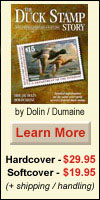 |
10% off on
web orders over $100 |
|
|

|
|
Junior duck stamp program good for kids, hobby
The federal junior duck stamp program is one of the best things to come from the United States government since it first authorized duck stamps for use by hunters in 1934. Established in 1993, the junior program reaches all 50 states, plus Washington, D.C.
Congress allocated funds to extend the program an additional five years, through 2005. Approximately 30,000 students and teachers participate in the annual competition. Robert C. Lesino, chief of the U.S. federal duck stamp office, told me that efforts are under way to add the U.S. possessions to the program.
As of this writing, Puerto Rico, Guam and American Samoa have been added, and the Virgin Islands and Northern Mariana Islands are considering the proposal. Opening the possessions to the program will give more talented kids the chance to shine.
The stamps and artwork are extremely well done, and a credit to the youth participating. The stamps have a face value of $5 but are not required for hunting. Sales are good, considering they are purchased voluntarily.
While most national winners have come from the higher-grade levels, local contests have been won by grammar school youngsters. Tennessee obtained special permission from the federal duck stamp office to use the artwork on its state duck stamp in 1999 and has used it since.
The 1999 Tennessee $10 Mallard duck stamp (Scott 21), illustrated in Figure 1, showcases the artwork of Bethany Carter. The agreement states that should Tennessee win the national junior competition the artwork may not be used on the stamp that year.
In such a case, the design of the Tennessee runner-up would be immortalized on the Tennessee duck stamp. Tennessee is a leader in using the art on its state stamp, and other states seem certain to follow, based on inquiries I have received.
The junior duck stamp program is a benchmark accomplishment, especially in the midst of the federal duck stamp office slashing various collector services.
o
State duck stamps have been sleeping giants for several years, but they are showing signs of coming to life.
In many states, oversupply has killed programs and hurt the total stamp-issuing effort. The advent of point-of-sale terminals also produced a sobering effect on stamp collectors, as economy-minded states began replacing colorful stamps with boring computer receipts.
Predictably, these changes resulted in less income, leaving officials wondering why duck stamp sales declined. A group of states continues stamps as a sidebar to the computer receipts, but the stamps are not valid to hunt ducks.
Hunting validity, however, is not a major concern, as most collectors do not use the stamps to hunt. Other states will mail (for free, or a small fee, depending on the state) a state duck stamp to those who request one.
As you can see, there is little common ground among the states regarding duck stamps. Basically, the states are concerned with implementation of their point-of-sale procedures, and they intend to address stamps later.
In 1996, Texas went to a point-of-sale system but continued to sell duck stamps. Unfortunately, its duck stamps are printed in a booklet pane of eight stamps. Seven of the hunting stamps are for trout, turkey and other animals; only one stamp is for ducks.
For example, the 2000 Texas duck stamp is the fourth stamp from the left in the top horizontal row of the pane, illustrated in Figure 2. Worse yet, Texas' policy requires selling only complete booklets. This forces dealers to buy seven other stamps to obtain the single duck stamp from each pane.
The result was predictable. Most dealers are up to their ear feathers in the other seven stamps from the pane, while collectors typically paid $10 and up for the single $3 duck stamp. The duck stamp from the 1996 hunting issue is mostly unavailable today, and the 1997 stamp is becoming scarce. Most dealers are out of these stamps, and demand is high.
Several dealers offered to pay above their listed retail prices to obtain examples for eager collectors. Another example of the gold-rush mentality is the Wyoming duck stamps. For years, the Scott duck stamp album provided space for only one Wyoming stamp - the issue of 1985.
The folly of this was recognized and changed a few years ago, creating a huge demand for the other stamps. Stamps from 1984 through 1992 that sold for $10 to $15 a few years ago began selling in the $35 to $95 range, with the 1989 stamp apparently being the scarcest.
In my experience, the most popular topical subjects pictured on state stamps are lighthouses and dogs. By my count, more than 100 state stamps feature them. All are in demand by thematic collectors. These popular stamps are scarce, and dealer prices have gone up.
Add to this a general shortage of 1993-98 state stamps that were on sale for a limited time. Dealers who usually purchased large quantities bought much less then because of sluggish demand.
Now demand is stronger, and dealers are scurrying about to obtain an adequate supply - a supply that is simply nonexistent. The increased efforts by dealers to buy these stamps should ultimately force higher selling prices.
I hope that our friends in the state licensing offices will realize the interest and income potential in this area and resume first-class state duck stamp programs. |
|
|



















